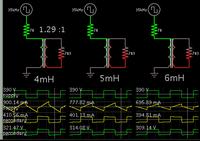T
treez
Guest

Hello,
The following two LTspice simulations are almost exactly the same (both full bridge SMPS’s)…They have the same NP/NS value, but slightly different primary and secondary inductance values.
Everything else is the same about these SMPS's.
So why does the one with lower primary inductance have a higher output voltage? (316V versus 301V)
Obviously its due to the extra magnetising inductance which keeps current flow into the secondary after the FETs have turned OFF, but why isn’t this documented anywhere?
By the way, the actual turns ratio, NS/NP = 1.288, and the “official” Vout value is Vout = NS/NP*D*VIN = 294V.
The following two LTspice simulations are almost exactly the same (both full bridge SMPS’s)…They have the same NP/NS value, but slightly different primary and secondary inductance values.
Everything else is the same about these SMPS's.
So why does the one with lower primary inductance have a higher output voltage? (316V versus 301V)
Obviously its due to the extra magnetising inductance which keeps current flow into the secondary after the FETs have turned OFF, but why isn’t this documented anywhere?
By the way, the actual turns ratio, NS/NP = 1.288, and the “official” Vout value is Vout = NS/NP*D*VIN = 294V.



